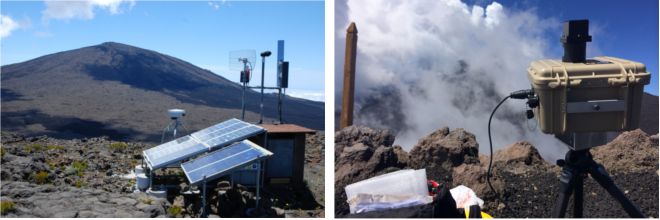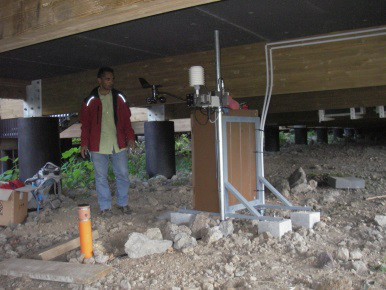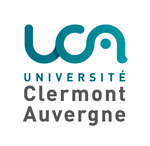Vous êtes ici : Accueil |
|
Routine Measurements We perform routine measurements on passive and active degassing as well as on eruptive products using various techniques: SO2 emission rates determined by ground-measurements (UV Spectrometers : DOAS / FLYSPEC) : SO2 emission rates, emitted during eruptive crisis or passive degassing,
are often correlated with other parameters such as: (i) the rising conditions and the
rheological properties of magma, (ii) the chemical and physical magmatic conditions
(iii) tremor and deformation, and (iv) the presence and intensity of any hydrothermal
activity (e.g. Rose et al., 1980; Andres et al., 1993; Symonds et al., 1994;
Edmonds et al., 2003
). Hence, a better understanding of SO2 fluxes improves not only our knowledge on the
various physic-chemical parameters that control the dynamics of degassing, but also our
prediction of volcanic hazards. Since the 1990s, SO2 emission rates have been measured
by UV correlation absorption spectroscopy (COSPEC; e.g. Stoiber et al., 1983;
Allard et al.,1994
; Williams-Jones et al., 2008
) and, more recently, by differential absorption spectroscopy (DOAS/FLYSPEC;
Galle et al., 2002
; Horton et al., 2006
). DOAS/FLYSPEC spectrometers, which have a small size (20 x 20 cm), low weight (0.4 kg),
minimal power consumption and low price, represent a huge step forward for volcanic
monitoring. The column abundances of SO2 in a plume cross-section are measured along
transects (slant or orthogonal) of the plume via traverses or scans from a fixed position.
SO2 flux is obtained by integrating these quantities and then scaling with the wind speed
along the plume axis.
In-Situ measurements of fumaroles and volcanic plumes by MultiGAS : Since volcanic plumes are necessarily a mixture of volcanic gases and air,
remote sensing of H2O and CO2 is limited by their high concentration in the atmosphere.
This can be overcome by the in-situ measurement of plumes near the crater or active
fumaroles, being careful to minimize chemical reactions or condensation effects.
Analysis of the volcanic contribution to the H2O and CO2 concentrations is obtained after
subtracting the atmospheric signal. The MultiGAS system is a robust, custom-made sensor
allowing high-frequency (0.1 Hz) real-time detection of multiple species like H2O and CO2
with NDIR spectroscopy and of SO2, H2S, CO, CH4 and H2 using electrochemical sensors,
along with key parameters (pressure, temperature, humidity) of the gaseous mix (
Shinohara, 2005
; Aiuppa et al., 2005
). Since about 10 years, MultiGAS has become widely used for gas studies (plumes and
fumaroles) and monitoring on volcanoes worldwide (see
Aiuppa et al., 2011
, Roberts et al., 2012
and references therein). The precision on concentrations in typically +/- 5-10%. The most
common method to provide flux data for various species is to combine MultiGAS measurements
(elemental ratios X/SO2, where X is any element in the gas) by SO2 flux data.
Direct gas measurements by Giggenbach bottles : Gas direct sampling by Giggenbach bottles (Giggenbach et Gogue, 1989)
is dangerous and often impossible, analyses can be long to perform and gases can sometimes
be contaminated by air. However, when possible, this technique provide the most complete
gas composition (concentrations and isotopes) .Volcanic gas streaming in a tube is
collected in pre-evacuated glass flasks partially filled with concentrated aqueous sodium
hydroxide (NaOH) or P2O5 dessiccant. When the tube is inserted into the fumarole or vent,
the gases bubble through the solution and acid gases like CO2, H2S, SO2, HCl and HF will
dissolve into the liquid. Inert gases that remain undissolved, such as N2, O2, H2, CO and
He, are collected in the head-space of the bottle and then analysed by gas chromatography.
Dissolved species are analysed by ion chromatography or traditional wet-chemical
techniques. Bulk analysis allows assessing the origin and nature of gas, its
physical-chemical conditions, and the different processes that modify the original
composition during ascent to the surface (e.g. Aguilera et al., 2011).
Plume filtration by Filter Packs : Volcanic gases and aerosols are considerably enriched in major (H2O, CO2,
SO2, H2S, HCl, HF, etc.) and minor (N2, rare gases, CO, CH4, H2, etc.) components but
also in many trace elements including alkali, alkali-earth, transition, and heavy metals
(e.g. Zoller et al., 1974). Volcanic gases and particles emitted into the atmosphere are
well known to participate significantly to pollution on a local and regional scale,
and represent the most important source of natural emissions for many significant
pollutants, such as sulphur and heavy metals for instance (e.g. Nriagu, 1989). The
diluted plume is pumped through 3 filters in series: 2 impregnated filters with a
caustic solution to trap acid gases (SO2, HCl, HF) and 1 filter to trap volcanic
aerosols rich in trace elements. Ionic chromatography and ICP-MS are used to measure
the gas and trace element concentrations, respectively (
Moune et al., 2010
; Menard et al., 2014;
Gauthier et al., 2016).
CO2 diffuse emissions from the soil Although the majority of volcanic gases are emitted around the main crater,
Allard et al. (1991) showed that a significant fraction of the degassing can percolate
through the sides of volcanic structures and be emitted by the ground. While reactive
gases, such as SO2 and HCl, are released at the crater, degassing at ground level releases
less reactive gases such as CO2. The study of soil degassing is important to complete the
mass balance of gaseous emissions from a volcano, as well as to detect significant
structures (e.g., fault, fractures;
Giammanco et al., 2006
; Lee et al, 2016
) and delineate the hydrothermal areas (e.g.,
Werner et al., 2008
). Indeed, correlation of soil gases and tectonic structures is an increasingly used
approach to monitor volcano activity. The temporal evolution of the gas fluxes near fault
zones, which represent highly permeable zones, is expected considering that CO2 is a poorly
soluble species in the silicate liquid, released to great depths during magma ascent and
decompression.
Volatile budget: Combining the study of fluid and melt inclusions : Measuring the amount and behaviour of dissolved volatile components in
magmas constitutes the first step to constrain modelling and interpretation of the
degassing processes and their link with volcanic activity. The pre-eruptive abundances
of dissolved volatiles can be retrieved, over a large pressure range (from mantle depth
to the surface), by probing the tiny droplets that become trapped in crystal phases during
magma ascent and are preserved as quenched melt (glassy) and fluid inclusions during
cooling (Anderson, 1974;
Lowenstern, 2003
). The residual volatile content of the degassed magma is determined by analysing the
groundmass (glass + microlites). Microanalysis is performed by integrating several
approaches (electron microprobe, LA-ICP-MS, Raman, SIMS, FTIR - see below for the
description) to get a full chemical characterization of the samples. These analyses are
performed at LMV and IPGP where we have extensive experience in performing such analyses
(e.g. Métrich et Wallace, 2008
; Di Muro et al., 2006
; Schiano, 2003
; Moune et al., 2007
; Moune et al., 2012
; Sigmarsson et al., 2013
; Venugopal et al., 2016).
Expected gas fluxes can be estimated by integrating degassing modelling with the volume
of erupted magma. The comparative study of expected (modelled) and measured gas
compositions permit to identify and quantify sink and sources of the volatile budget for
a given volcanic system. Quantification of source terms is of paramount importance for
accurate modelling of eruptive plume dynamics (Di Muro et al., 2015).
Chemistry : GAZVOLC use also facilities at LMV and IPGP :
|







